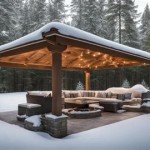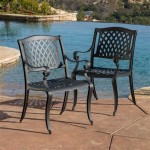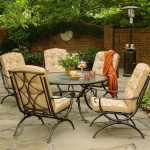Elevating Outdoor Living: Balcony and Patio Ideas for Enhanced Spaces
Outdoor spaces, whether compact balconies or expansive patios, offer opportunities to extend living areas beyond interior walls. Thoughtful design and strategic implementation of various elements can transform these areas into functional and aesthetically pleasing extensions of the home. This article explores a range of balcony and patio ideas, focusing on key aspects that contribute to creating inviting and usable outdoor environments.
Optimizing Space and Functionality
Maximizing space is paramount, especially in smaller balconies. Multifunctional furniture provides practical solutions. Benches with built-in storage can serve as seating while concealing cushions, gardening tools, or other outdoor essentials. Folding tables and chairs offer versatility, allowing for dining or relaxation without permanently occupying valuable space. Wall-mounted planters or vertical gardens are effective ways to introduce greenery without sacrificing floor area. Utilizing the vertical dimension not only adds visual interest but also creates a more enclosed and private feel.
Consider the primary intended use of the balcony or patio. A dining area requires a table and chairs, potentially with an umbrella for shade. A relaxation zone might incorporate comfortable seating, such as lounge chairs or a hammock, along with side tables for drinks and books. An outdoor workspace could include a small desk, a comfortable chair, and adequate lighting. Defining zones within the space, even in smaller areas, helps to organize the area and enhance its functionality. This could involve using rugs to delineate different areas or employing screens or planters to create visual separation.
Lighting is crucial for extending the usability of the balcony or patio into the evening hours. String lights, lanterns, or outdoor-rated lamps can provide ambient lighting, creating a warm and inviting atmosphere. Solar-powered lights offer an energy-efficient option, while dimmable lights allow for adjusting the brightness to suit different moods and activities. Strategically placed spotlights can highlight architectural features or plants, adding depth and visual interest. Path lighting can also improve safety and navigation, particularly in larger patios.
Weather considerations are also relevant. Depending on the climate, shade solutions are essential for protecting against harsh sunlight. Awnings, pergolas, or umbrellas can provide shade during the day, while retractable options offer flexibility. Windbreaks, such as screens or hedges, can shield the area from strong winds, making it more comfortable to use. In colder climates, outdoor heaters or fire pits can extend the outdoor season, allowing for enjoyment of the space even during cooler months.
Selecting appropriate materials is paramount. Outdoor furniture should be durable and weather-resistant, capable of withstanding exposure to sunlight, rain, and temperature fluctuations. Teak, cedar, and treated pine are popular choices for wood furniture, while aluminum and wrought iron offer lightweight and rust-resistant options. Cushions and fabrics should be made from outdoor-rated materials that are resistant to fading, mildew, and water damage. Flooring options include wood decking, composite decking, pavers, and concrete, each offering different aesthetic and functional characteristics. The choice of materials should complement the overall design and withstand the specific environmental conditions of the location.
Creating Ambiance and Aesthetics
The overall aesthetic of the balcony or patio should complement the style of the home. A modern home might benefit from clean lines, minimalist furniture, and a neutral color palette. A traditional home might incorporate more ornate furniture, patterned fabrics, and a warmer color scheme. The key is to create a cohesive and harmonious look that reflects the homeowner's personal style.
Color plays a significant role in setting the mood and atmosphere of the outdoor space. Bright and vibrant colors can create an energetic and cheerful environment, while muted and neutral colors can evoke a sense of calm and relaxation. Consider the surrounding landscape and architecture when selecting colors, aiming for a palette that complements the existing environment. Introducing pops of color through cushions, planters, or artwork can add visual interest without overwhelming the space.
Greenery is an essential element in creating a welcoming and inviting outdoor space. Plants can soften hard surfaces, add texture and color, and create a sense of connection with nature. Consider the amount of sunlight available when selecting plants, choosing species that are well-suited to the specific conditions of the balcony or patio. Container gardening is an effective way to introduce plants, allowing for flexibility and easy maintenance. Hanging baskets, window boxes, and vertical gardens can further enhance the greenery and add visual interest.
Adding personal touches can transform a generic balcony or patio into a unique and personalized space. Artwork, sculptures, and decorative objects can reflect the homeowner's interests and personality. Outdoor rugs can add warmth and texture, defining different areas and creating a more inviting atmosphere. Throw pillows and blankets can add comfort and color, while candles and lanterns can create a warm and romantic ambiance. Incorporating elements that are meaningful and personal can make the space feel more like an extension of the home.
Privacy is often a concern, especially in urban environments. Screens, trellises, or hedges can provide privacy without completely blocking the view or light. Bamboo screens are a lightweight and natural option, while metal screens offer a more modern and durable solution. Climbing plants, such as ivy or clematis, can be trained to grow on trellises, creating a living green wall that provides privacy and visual interest. Consider the height and density of the privacy screen to ensure adequate coverage while maintaining a sense of openness.
Enhancing Functionality with Specific Features
For those who enjoy cooking and entertaining outdoors, an outdoor kitchen can be a valuable addition to a patio. A simple outdoor kitchen might consist of a grill, a countertop, and some storage space. A more elaborate outdoor kitchen could include a sink, a refrigerator, and even a pizza oven. The design and features of the outdoor kitchen should be tailored to the homeowner's specific needs and preferences. Consider the proximity to the indoor kitchen and the availability of utilities when planning an outdoor kitchen.
Water features, such as fountains or ponds, can add a sense of tranquility and relaxation to the outdoor space. The sound of running water can be soothing and can help to mask unwanted noise from the surrounding environment. Fountains come in a variety of styles and sizes, from small tabletop fountains to large freestanding fountains. Ponds can be more elaborate, requiring careful planning and maintenance. Consider the size of the space and the availability of water and electricity when planning a water feature.
Fire pits or fireplaces can extend the outdoor season, allowing for enjoyment of the space even during cooler months. Fire pits are typically less expensive and easier to install than fireplaces, while fireplaces offer a more substantial and permanent structure. Consider the safety aspects of fire pits and fireplaces, ensuring that they are located a safe distance from flammable materials and that they are used in accordance with local regulations. Wood-burning fire pits and fireplaces require a supply of firewood, while gas-burning options offer convenience and ease of use.
Creating an outdoor bar area can be a great addition for those who enjoy entertaining. This could involve a simple bar cart or a more elaborate built-in bar with a countertop, storage space, and possibly a sink. Bar stools or comfortable seating around the bar area will encourage guests to gather and socialize. Consider adding features like a built-in ice maker or a beverage refrigerator to keep drinks cold.
Integrating technology can enhance the enjoyment of outdoor spaces. Outdoor-rated televisions and sound systems can provide entertainment, while smart lighting systems can be controlled remotely. Consider the weather resistance and durability of electronic devices when selecting them for outdoor use. Smart home integration can allow for controlling lighting, temperature, and entertainment systems from a smartphone or tablet.
Planning is an important aspect of creating an enjoyable outdoor space. All of the elements should be considered before implementation to ensure the outdoor space will be both functional and pleasing.

20 Apartment Balcony Ideas For The Prettiest Outdoor Perch

How To Make The Most Out Of Small Balconies And Patios Granny Co Homes

Spring Balcony Ideas Transform Even The Smallest Outdoor Space Homedesignsai

12 Small Balcony Ideas That Prove Just How Much Can Be Done With The Tiniest Of Outdoor Spaces Real Homes

10 Apartment Patio Ideas To Transform Your Outdoor Space Draper And Kramer Incorporated

20 Small Balcony Ideas And Designer Examples

Best Decorated Small Outdoor Balconies Inspirational Images
.jpg?strip=all)
6 Modern Outdoor Balcony Furniture Layout Ideas Laskasas

Outdoor Entertaining With A Small Balcony The Home

Balcony Design How To Give Your Space The Patio Treatment
See Also








